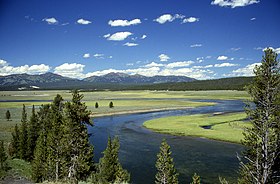From Wikipedia, the free encyclopedia
For the 2005 science docufiction disaster television film, see Supervolcano (film).
A supervolcano is a volcano capable of producing a volcanic eruption with an ejecta volume greater than 1,000 km3 (240 cu mi). This is thousands of times larger than normal volcanic eruptions.[1] Supervolcanoes can occur when magma in the mantle rises into the crust from a hotspot
but is unable to break through the crust. Pressure builds in a large
and growing magma pool until the crust is unable to contain the pressure. They can also form at convergent plate boundaries (for example, Toba) and continental hotspot locations (for example, the Yellowstone Caldera).Although there are only a handful of Quaternary supervolcanoes, supervolcanic eruptions typically cover huge areas with lava and volcanic ash and cause a long-lasting change to weather (such as the triggering of a small ice age) sufficient to threaten species with extinction.
Yellowstone Caldera
From Wikipedia, the free encyclopedia

The northeastern part of Yellowstone Caldera, with the Yellowstone River flowing through Hayden Valley and the caldera rim in the distance
The Yellowstone Caldera is the volcanic caldera located in Yellowstone National Park in the United States, sometimes referred to as the Yellowstone Supervolcano. The caldera is located in the northwest corner of Wyoming,
in which the vast majority of the park is contained. The major features
of the caldera measure about 34 by 45 miles (55 by 72 km).[3]Contents
Volcanism
Yellowstone lies over a hotspot where light, hot, molten mantle rock rises toward the surface. While the Yellowstone hotspot is now under the Yellowstone Plateau, it previously helped create the eastern Snake River Plain (to the west of Yellowstone) through a series of huge volcanic eruptions. The hotspot appears to move across terrain in the east-northeast direction, but in fact the hotspot is much deeper than terrain and remains stationary while the North American Plate moves west-southwest over it.[4]Over the past 18 million years or so, this hotspot has generated a succession of violent eruptions and less violent floods of basaltic lava. Together these eruptions have helped create the eastern part of the Snake River Plain from a once-mountainous region. At least a dozen of these eruptions were so massive that they are classified as supereruptions. Volcanic eruptions sometimes empty their stores of magma so swiftly that they cause the overlying land to collapse into the emptied magma chamber, forming a geographic depression called a caldera. Calderas formed from explosive supereruptions can be as wide and deep as mid- to large-sized lakes and can be responsible for destroying broad swaths of mountain ranges.
No comments:
Post a Comment